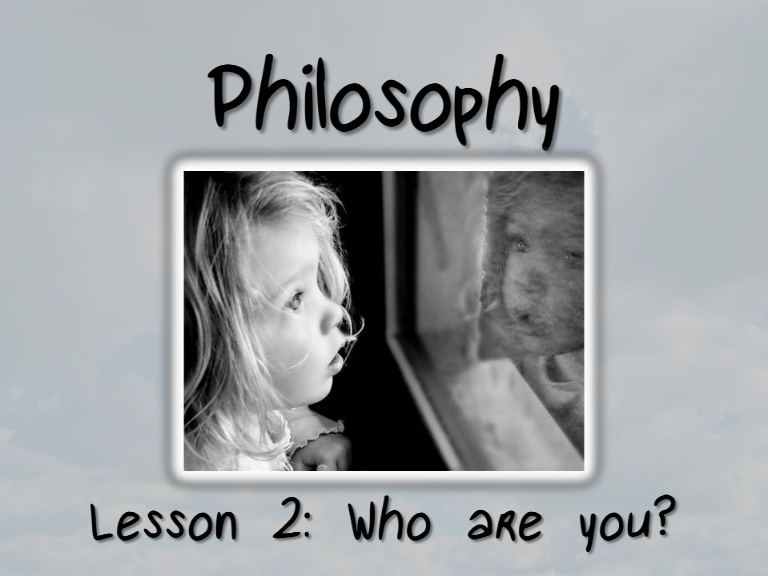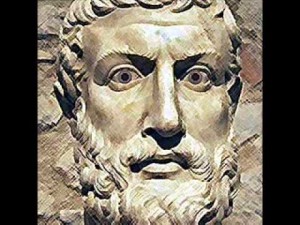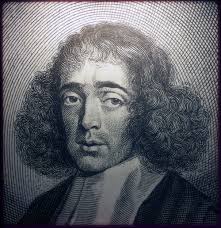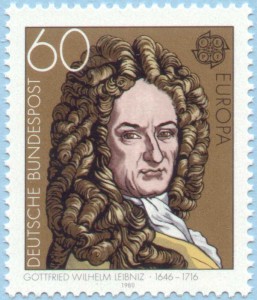Rationalists consider that truths about reality can only be revealed through reason, not by believing what the senses tell us about the world.
Parmenides can be considered the first Rationalist because he thought that the material world could only be properly understood by thought and reason, not what is perceived through senses.
Parmenides’ idea have survived in fragments of a long poem he wrote. The poem has two main themes: “The Way of Truth” (what reason tells us about the world and “The Way of Seeming” (what our senses tell us). Parmenides argued that thinking and being (existing) are one and the same, meaning that it is impossible to think of a thingthat does not exist.His logic was that “nothing” can only be thought about if it is thought of as “something”.Therefore nothing, or “not being”, is not possible — there can only be “being”. In the same poem, Parmenides reasoned that time is an illusion. He said that the past and future do not exist since they can only be thought of in the present.
Descartes is credited with being the first “modern” philosopher. He broke the hold of Scholasticism on philosophy by questioning everything he had been taught. Descartes was a scientist. This gave him the desire to establish a deductive system of knowledge that would give him logical, necessary truths about the universe.
In his book “The Meditations”, Descartes set out to discover a firm foundation for his system. He realized that everything he knew had been learned from his senses. But he questioned whether it was sensible to trust a known liar. How could he trust his senses when, for example, an oar looks bent in water? Descartes’ method was to doubt everything systematically. All that was left was the secure knowledge he could think, even if he was only dreaming that he was thinking. This was the foundation stone for his new system of knowledge. The first deduction that he could make from this indisputable truth was that, by virtue of thinking, he must exist. However, he had thought himself into a philosophical corner. How could he prove that the outside world also existed? How could he now trust what he perceived about the world? The only solution was to prove the existence of God — only then could he deduce that his own God-given senses could be trusted. Many philosophers consider that Descartes’ thinking went downhill at this point.
Descartes came up with two arguments for God’s existence. The first was that he (Descartes), by virtue of his doubts, was an imperfect being. However, imperfect as he was, he could still entertain the idea of a perfect being — God. Only a perfect being could be the cause of such a perfect idea. Therefore, God must exist. Descartes’ second argument is a variation of St Anselm’s “ontological” proof. Descartes argues that the idea of a perfect being contains perfection in every degree. Therefore the idea of God must contain God’s existence. Having “proved” God’s existence, Descartes no longer needed to consider that the world might be the product of an evil genius. He reasoned that a perfect being would not allow such a state of affairs.
Descartes still had to know how he knew about the world. As a thinking being he reasoned that his God-given senses would not deceive him if they were properly employed. He deduced that it was mind, or reason, that told him the truth about the world. When he melted wax, it looked, felt, and smelled different, but in his mind he was in no doubt at all that the substance was still wax.
 The building block of Descartes’ rational system was his assertion “I think, therefore I am” (from the Latin: cogito ergo sum). By this Descartes had identified mind as something separate from matter. In this sense, he is known as a “dualist” philosopher, meaning that he thought that the world consisted of two separate substances: mind and matter. The essential property of the mind is consciousness, whereas the essential property of matter is “extension” in space, in that it has length, breadth, and depth. In his view, all matter, including the human body, is “mindless”. All living things are just matter in motion. This dualist philosophy left Descartes with the problem of explaining how the mind and body united to become a person. He theorized that the double impression received by virtue of having two ears , two eyes, two hands (and so on) united with consciousness in a gland in the brain. This theory was hotly debated, even before his death, and Descartes himself was aware of the unsatisfactory nature of this conclusion. One of those who questioned his theory was queen Christina of Sweden. She also disagreed with Descartes’ view that animals were mindless, Having observed her own much-loved pets.
The building block of Descartes’ rational system was his assertion “I think, therefore I am” (from the Latin: cogito ergo sum). By this Descartes had identified mind as something separate from matter. In this sense, he is known as a “dualist” philosopher, meaning that he thought that the world consisted of two separate substances: mind and matter. The essential property of the mind is consciousness, whereas the essential property of matter is “extension” in space, in that it has length, breadth, and depth. In his view, all matter, including the human body, is “mindless”. All living things are just matter in motion. This dualist philosophy left Descartes with the problem of explaining how the mind and body united to become a person. He theorized that the double impression received by virtue of having two ears , two eyes, two hands (and so on) united with consciousness in a gland in the brain. This theory was hotly debated, even before his death, and Descartes himself was aware of the unsatisfactory nature of this conclusion. One of those who questioned his theory was queen Christina of Sweden. She also disagreed with Descartes’ view that animals were mindless, Having observed her own much-loved pets.Like Descartes, Spinoza believed that reason was the true source of all knowledge. Like Descartes, he was brilliant at mathematics and geometry and agreed that philosophy should try to copy their methods of deduction. Spinoza’s aim was to construct a “geometry of philosophy”. In his most important book, “The Ethics“, he tries to demonstrate by means of a mathematical system how to lead a good life. The foundation stone of Spinoza’s system is the indisputable truth of God’s existence. Everything else in Spinoza’s system develops from this. He arrived at this truth by way of trying to solve the problem posed by Descartes’ belief that the universe consisted of two substances: mind and matter. Descartes called them “finite substances”. Beyond these is God, the “infinite substance”. Spinoza felt that this was contradictory.
Spinoza agreed with Descartes’ definition of substance, which is something that does not depend on anything else for its existence. But Spinoza felt that Descartes should have stopped once he identified God as the “infinite substance”, because an “infinite substance” would also possess all the properties of the “finite substance”, — so how could these exist independently? In this way Spinoza was able to argue that god is not separate from the rest of the universe, as Descartes (and nearly everyone else) had thought. Rather, God and the universe are one and the same. Spinoza insisted that God and nature are one substance and that mind and matter are just different forms in which God appears. Spinoza thought that there might be many other ways in which God appears, but that human senses are too limited to perceive them. Spinoza’s belief in one substance makes him a “Monist”.
 Spinoza was also a “Determinist”, in that he believed that everything that happens in the world is part of a divine plan. This might seem to negate the possibility of freedom in Spinoza’s system. But Spinoza disagreed. He thought that the only way to be free is for people to accept what they are. Spinoza believed that knowing ourselves clearly is part of coming to understand God. This makes sense in terms of Spinoza’s system because, if God is everywhere and everything, each person is part of God. Spinoza said that the more people understand their relationship to the rest of the world, the more free they will feel. The realization that there is no randomness is liberating because it frees people from being ruled by their emotions. To Spinoza, it was not “reasonable” to feel anger if someone hurt you. there was no point. It would not change a thing. A person with a clear understanding of the world (and therefore of God) accepts whatever happens.
Spinoza was also a “Determinist”, in that he believed that everything that happens in the world is part of a divine plan. This might seem to negate the possibility of freedom in Spinoza’s system. But Spinoza disagreed. He thought that the only way to be free is for people to accept what they are. Spinoza believed that knowing ourselves clearly is part of coming to understand God. This makes sense in terms of Spinoza’s system because, if God is everywhere and everything, each person is part of God. Spinoza said that the more people understand their relationship to the rest of the world, the more free they will feel. The realization that there is no randomness is liberating because it frees people from being ruled by their emotions. To Spinoza, it was not “reasonable” to feel anger if someone hurt you. there was no point. It would not change a thing. A person with a clear understanding of the world (and therefore of God) accepts whatever happens.For Spinoza, the happiest people are those who put God first — not a God that exist a higher being, but the some total of everyone and everything in the cosmos. In this way, Spinoza thought he had invented a perfectly rational form of ethics. People who act unselfishly are happy in the sure knowledge that they are leading good lives.
German philosopher Leibniz was the last great rationalist philosopher. Unlike Spinoza, who thought there is only one substance, Leibniz believed that the universe is made up of an infinite number of substances, each one unique. He called these substances “monads” and argued that each monad reflected everything else in the universe.
It is possible to imagine what Leibniz meant by thinking of a mirrored ball. If you look at a mirrored ball, you see your reflection and what is in the space around you. However, instead of just reflecting the immediate surroundings, Leibniz’s monads reflect the entire universe. This means that everything in the world is connected to everything else. Instead of thinking about the world as a complex jumble of space, time, and matter, Leibniz introduces the idea that each moment and place is connected to every other. No nomad is unconnected.
However, Leibniz also argued that nomads do not act upon each other. Instead, he said that each nomad was set upon its course from the beginning. According to Leibniz, every thing that exists and happens, exists and happens for a reason. For there to be no reason, Leibniz reasoned, would be irrational. This was the building block of Leibniz’s system of thought. Like many philosophers before him, Leibniz traced the cause of “everything that is” back to God. It was God who set in motion the myriad monads that make up reality, and each monad carries within it all that it will ever be.
Leibniz called this idea that everything is programmed in advance by God “pre-established harmony”. Leibniz reasoned that this world is just one of an infinite number of possible worlds, but because God chose to bring it into existence, then it is logical that this must be the best of all possible worlds. This is because God is a perfect being and so would never have chosen anything but the best. 




